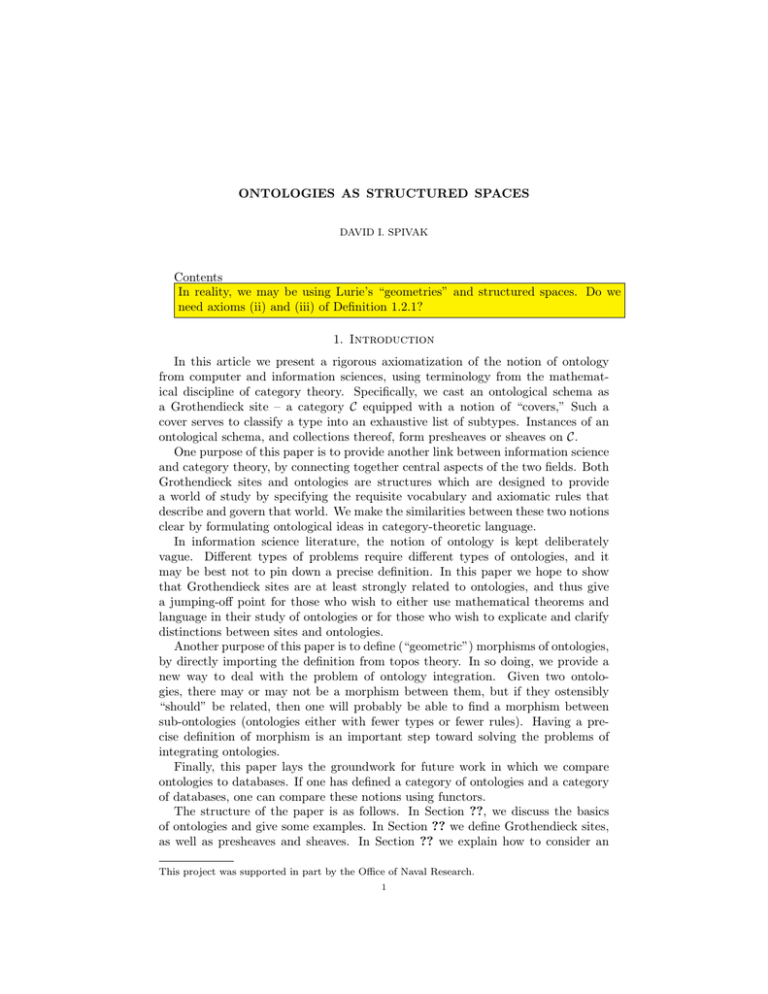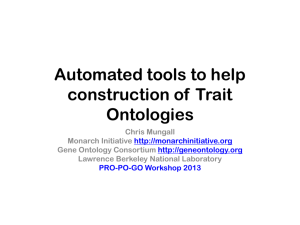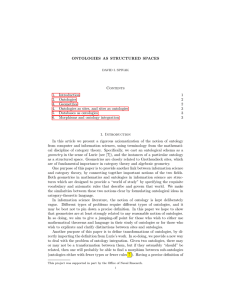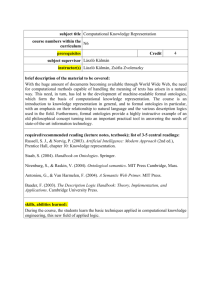ONTOLOGIES AS STRUCTURED SPACES Contents
advertisement

ONTOLOGIES AS STRUCTURED SPACES
DAVID I. SPIVAK
Contents
In reality, we may be using Lurie’s “geometries” and structured spaces. Do we
need axioms (ii) and (iii) of Definition 1.2.1?
1. Introduction
In this article we present a rigorous axiomatization of the notion of ontology
from computer and information sciences, using terminology from the mathematical discipline of category theory. Specifically, we cast an ontological schema as
a Grothendieck site – a category C equipped with a notion of “covers,” Such a
cover serves to classify a type into an exhaustive list of subtypes. Instances of an
ontological schema, and collections thereof, form presheaves or sheaves on C.
One purpose of this paper is to provide another link between information science
and category theory, by connecting together central aspects of the two fields. Both
Grothendieck sites and ontologies are structures which are designed to provide
a world of study by specifying the requisite vocabulary and axiomatic rules that
describe and govern that world. We make the similarities between these two notions
clear by formulating ontological ideas in category-theoretic language.
In information science literature, the notion of ontology is kept deliberately
vague. Different types of problems require different types of ontologies, and it
may be best not to pin down a precise definition. In this paper we hope to show
that Grothendieck sites are at least strongly related to ontologies, and thus give
a jumping-off point for those who wish to either use mathematical theorems and
language in their study of ontologies or for those who wish to explicate and clarify
distinctions between sites and ontologies.
Another purpose of this paper is to define (“geometric”) morphisms of ontologies,
by directly importing the definition from topos theory. In so doing, we provide a
new way to deal with the problem of ontology integration. Given two ontologies, there may or may not be a morphism between them, but if they ostensibly
“should” be related, then one will probably be able to find a morphism between
sub-ontologies (ontologies either with fewer types or fewer rules). Having a precise definition of morphism is an important step toward solving the problems of
integrating ontologies.
Finally, this paper lays the groundwork for future work in which we compare
ontologies to databases. If one has defined a category of ontologies and a category
of databases, one can compare these notions using functors.
The structure of the paper is as follows. In Section ??, we discuss the basics
of ontologies and give some examples. In Section ?? we define Grothendieck sites,
as well as presheaves and sheaves. In Section ?? we explain how to consider an
This project was supported in part by the Office of Naval Research.
1
2
DAVID I. SPIVAK
ontology as a site and a site as an ontology by giving a dictionary relating their
respective vocabularies, and by providing examples. Finally, in Section ?? we
discuss morphisms of sites and show their applicability to ontology integration
problems.
2. Ontologies
3. Grothendieck Sites
We begin by recalling the definition of a site.
Definition 3.0.1. A site is a pair (C, J), where C is a category and J is a function
that assigns to each C ∈ Ob(C), a set J(C) in which each element T ∈ J(C) is
itself a set T = {tα : cα → C} of morphisms in C with target C; these data are
required to satisfy axioms which we present after defining some terms. We call
the sets T ∈ J(C) trait classifications on C and individual morphisms t ∈ T trait
classes on C. We require the following:
(1) For each trait class t : c → C on C and each map D → C in C, the fiber
product c ×C D exists in C.
(2) For any map f : D → C in C and any trait classification T ∈ J(C), the
pullback f ∗ T = {g ∗ (t)|t ∈ T } is a trait classification on D.
(3) If T = {tα : cα → C} is a trait classification on C and for each tα ∈ T the
set Uα = {uα,β : bα,β → cα } is a trait classification on cα , then the family
of composites
o
[ n
tα ◦uα,β
bα,β −−−−−→ C|uα,β ∈ Uα
tα ∈T
is a trait classification on C.
(4) If f : B → C is an isomorphism in C then the singleton set {f } is a trait
classification on C.
Definition 3.0.2. Let (C, J) denote a site, X a topological space, and Shv(X) the
category of sheaves of sets on X. A functor F : C → Shv(X) is called topological
if it preserves the finite limits which exist in C and if, for every trait classification
T ∈ J, the induced map of sheaves
a
F (cα ) −→ F (C)
(tα : cα →C)∈T
is surjective.
Given a pair of topological functors F, G : C → Shv(X), we will say that a
natural transformation a : F → G is topological if, for every trait class c → C, the
induced diagram of sheaves
is a pullback square in Shv(X).
F (c)
/ G(c)
F (C)
/ F (C)
ONTOLOGIES AS STRUCTURED SPACES
3
Example 3.0.3. If X is a point, then Shv(X) = Sets is the category of sets. A
functor F : C → Sets is topological if it preserves finite limits and takes trait
classifications to surjections.
I think that if X is sober, then a functor F : C → Shv(X) is local if, for each
point x ∈ X, the induced functor Fx : C → Sets on stalks (given by composition of
F with colimx∈U −(U ) : Shv(X) → Sets) is topological.
Definition 3.0.4. Let F : C → Sets be a topological functor, and let D = {(C1 , T1 ), . . . , (Cn , Tn )}
denote a finite set of pairs (Ci , Ti ) in which Ci ∈ Ob(C) is an object and Ti ∈ J(Ci )
is a trait classification on C. The D-display of F is
4. Ontologies as sites, and sites as ontologies
5. Morphisms and ontology integration






